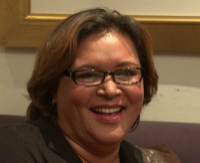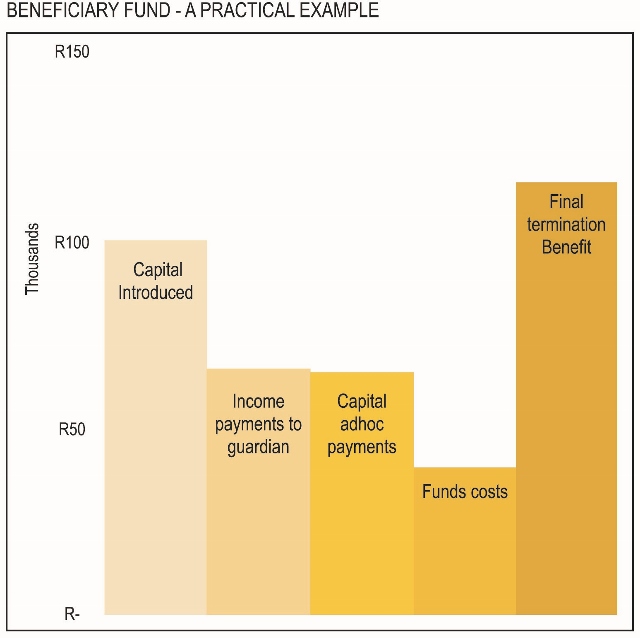|
Fairheads Times June 2015
This has been an exciting year thus far for Fairheads. We've reached a milestone in Fairheads' history. Read about it in the Message from the CEO.
We are also happy to announce that Fairheads was named the Trust & Beneficiary Fund Administrator of the Year at the Imbasa Yegolide Awards earlier this week. This industry accolade motivates us to continue to provide our clients with service excellence.
Enjoy the read and keep in touch.
 TIME TO RECONSIDER LUMPSUM PAYMENTS FOR MINOR CHILDREN
In terms of section 37C of the Pension Funds Act, the trustees of retirement funds have four options when deciding how to allocate benefits due to minor dependants/nominees who have lost a breadwinner. They can pay a lump sum benefit to the guardian; retain and administer the monies in the retirement fund; pay the funds to a trust (if a trust nominated by the member or guardian); or pay them to a beneficiary fund, which is the pension fund vehicle government introduced in 2009 to safely house the assets of “widows and orphans.”
There is a false perception in the industry that the Pension Funds Adjudicator is not in favour of beneficiary funds. However there have only been a relatively few instances in which the decision to place monies in beneficiary funds has been set aside. On the other hand, the question of whether due process has been followed by trustees in arriving at their decision has always been an issue.
The entire area of death claims is complex and wide-ranging and beneficiary funds remain relatively new, but I believe there are a few additional issues that have been overlooked:
BROADER INDUSTRY REFORM
Lump sum payments for children do not sit easily with the broader pension reform currently being undertaken, especially the adoption of the annuitisation principle for all retirement benefits and the general move away from lump sum payments.
If government and the regulator are of the view that retirees should not receive lump sums at retirement, then I believe that it would be imprudent to pay children’s benefits as lump sums.
This situation has been cogently argued in an article published in Insurance & Tax in December 2014 by Naleen Jeram, a senior legal advisor at Momentum Employee Benefits and Adjunct Professor at UCT Law Faculty, in which he calls inter alia for simplification of the section 37C process.
WHY SHOULD CHILDREN BEAR THE RISK OF LUMP-SUM PAYMENTS?
It also seems unreasonable to expect children to bear the risk of lump-sum payments to their guardian as they have no power to determine how the guardian spends the money. The current test applied by law and followed by the PFA is that if the guardian is “competent”, based on an investigation into their educational status, financial literacy and ability in practice to manage their own financial affairs, then trustees should pay the child’s death benefit to the guardian.
But sadly financial competency is no guarantee that the guardian would use the funds in the best interests of the child. Mr Jeram states in the same article:
“This legal test is based on the premise/assumption that financial competency leads to monies being utilized in the interest of minors. However, one may have a guardian who is very well qualified in finances and financial planning and has a very good track record of handling monies, but does that really mean he/she will use the monies in the best interests of the minor children?”
As a guide to help trustees in their decision of where to place a lump sum I would suggest they ask the following questions:
- Will the money be used in the best interests of the child?
- Will the money be stretched as far as possible to ensure the child gets the best education available?
- Can the money practically be ring fenced if the guardian dies?
- Can the guardian access the expertise required to achieve the best returns, at a reasonable cost?
The truth is that beneficiary funds meet all the above criteria. After all, government set up these funds expressly for the purpose of protecting and managing minors’ assets on an annuity principle. Once the lump sum has been paid into a beneficiary fund, the guardian receives a monthly amount to use for supporting the child and can request capital amounts to be paid for school fees and similar maintenance related expenses.
NOT ENOUGH KNOWN ABOUT THE BENEFITS
I believe trustees are not yet sufficiently aware of the advantages of beneficiary funds. They are cost effective and tax effective, and offer institutional investment returns. They are taxed in the same manner as pension funds in South Africa, that is, no tax is paid in the fund. Furthermore, any payment out of a beneficiary fund, whether capital or income, is tax free.
Although some beneficiary fund accounts run into millions of rands, the average size is around R100 000 which, if carefully managed, can provide a monthly income and finance a child’s entire education through to tertiary level. When the member turns 18, the account is terminated and the funds paid out unless the member requests they remain in the beneficiary fund.

The graph illustrates an example of a member, aged five years at inception, with an original capital investment of R100 000. The funds are invested according to the beneficiary fund board approved asset allocation model and payments from the fund include:
- Regular income payments to the guardian until the child reaches the age of majority
- Annual capital payments for education related expenses
- All fund costs
- A final termination benefit of approximately R115 000 payable in a lump sum to the member upon reaching the age of majority.
The example illustrates how a relatively small investment of R100 000 can be stretched over a period of 13 years to provide for the education and well-being of the minor child, as well as preserving capital for a lump sum payout on termination.
I doubt there are many guardians who could achieve that on their own. Even if they used investment experts, there are investment fees to consider as well as the tax implications.
Note: The above example is based on Fairheads Umbrella Beneficary Fund approved asset allocation model which is reblended annually. Historical investment returns have been used to project future investment returns (money market 12 month performance, income fund 36 month performance, stable funds 36 month performance and balanced fund 60 months performance). The example includes annual capital payments equivalent to 5% of capital introduced, income payments of 5% of capital introduced (paid monthly) and includes all fees and charges.
 MESSAGE FROM THE CEO
On behalf of Fairheads, I am pleased to announce that Fairheads has concluded a BEE transaction that has resulted in Vunani Capital Proprietary Limited (”Vunani”) acquiring a majority shareholding in Fairheads International Holdings (SA) (Pty) Ltd, which owns Fairheads Benefit Services (Pty) Ltd.
This is an exciting milestone in our history and we look forward to our association with Vunani, a well-established BEE company in the financial services sector. Fairheads will continue to be run as an independent company within the Vunani Group and retain its independent status in the market.
Fairheads’ senior management team, including myself as Chief Executive Officer, will remain significant shareholders and this continuity is an important part of the transaction. It will ensure that the skills and expertise of the management team remain in the business. Fairheads’ retirement fund clients and the beneficiaries of those clients remain Fairheads’ number one priority and the transaction with Vunani has been structured so that there is no disruption to Fairheads’ operating activities and the high standards of performance that we set for ourselves.
Ethan Dube, the Chief Executive Officer of Vunani Limited, and Mark Anderson, an Executive Director of Vunani Limited, will join the board of directors of Fairheads. Ethan will become Fairheads’ Chairman. We value our long association and partnership with all our stakeholders and look forward to growing this partnership into the future.
 AGE 18 - IS IT APPROPRIATE?
Following years of verbal engagement, a formal written submission has recently been made to the Financial Services Board to amend pension fund legislation such that death benefit lump sums administered by beneficiary funds, umbrella trusts or retirement funds on behalf of minor dependants not be automatically paid out to such minors when they turn 18. The submission was made on behalf of the industry via the Institute for Retirement Funds Africa (IRFA).
BACKGROUND
The Children’s Amendment Act 41 of 2007 changed the age of majority from 21 years to 18 years. As a consequence of this Act, retirement funds, trusts and now beneficiary funds (which the Pension Funds Act first provided for in 2009) have had to pay out lump sum death benefits at age 18 to their members/beneficiaries. (Exceptions to this are if a beneficiary has a legal disability which prevents them managing the money themselves, or if the beneficiary has consented to the money continuing to be administered by the beneficiary fund or trust for themself.)
In the South African context, the assumption is that minors attain the age of 18 in Grade 12 (Matric), if they are in their age-related grade. Statistically however, less than 50% of children are in matric at age 18, with some in lower grades and others having already dropped out of school completely having never attained matric.
Since the reduction in the age of majority to 18 years, it has become quite evident that paying lump sums from beneficiaryfunds/trusts and retirement funds to children aged 18 years, and who are still at school, is not ideal for the following reasons:
-
A very low percentage of learners achieve matric, or any other NQF level 4 qualification, at age 18, as the statistics from the Department of Education demonstrate.
- A large number of children have elected to drop out of school once they receive their lump sum at age 18. This has an impact on their continuing education prospects, their future employment opportunities and in turn possible financial support that they might otherwise be able to provide to their families if they did have an education and employment.
- At the age of 18, very few (if any) of these children have the financial knowledge and skill to properly manage that money. There is a very real risk that the children receiving these lump sums often spend these funds carelessly and recklessly, with ittle thought of acquiring the skills to become financially independent.
- Where 18 year old beneficiaries are counselled to seek financial advice or on how to manage their finances responsibly, less than 5% follow this advice.
- When given the option by a retirement fund to place their portion of a death benefit in a beneficiary fund, because they are still at school, beneficiaries seldom exercise this option.
Further, beneficiaries who are still at school seldom consent to retaining their funds in beneficiary funds on attaining the age of 18 years.
In Fairheads’ experience over the past five years, most guardians and caregivers have been strongly opposed to children receiving lump sum pay-outs at age 18, while they are still completing their school education. Many of these children are still living at home and are not willing to make a financial contribution to the household.
Feedback has also been received over the years at roadshows conducted by various beneficiary funds and trusts from guardians and caregivers who have advised the presenters that they have refused to hand over documentation for their children to complete, where it is evident that at age 18 the children will receive lump sums while they are still attending school. This is because of their serious concerns that the children will squander the money and possibly drop out of school after receiving the money.
PROPOSED CHANGES
To address the concerns set out above it is proposed that section 37C(2) be amended to provide for the following:
1. A dependant or nominee (defined as a “beneficiary” in the Pension Funds Act), whose death benefit is being administered by a retirement fund (and not a beneficiary fund or trust), as well as any member of a beneficiary fund, should only be allowed to receive a lump sum benefit (i.e. any balance remaining for them in the retirement fund or the beneficiary fund at termination date) if:
a. They are at least 18 years of age and have a matric certificate or an equivalent NQF Level 4 qualification; or
b. They are at least 21 years of age
2. It is suggested that it would also be prudent to retain discretion for the trustees to be able to pay the lump sum benefit to a beneficiary or member of the beneficiary fund who does not meet the above conditions. This is because there may well be good reasons to allow such a payment, for example, the beneficiary or member is under age 21 but is employed and is unlikely to return to school to obtain the necessary qualification, or the remaining lump sum benefit is a small amount. The need for a wider discretion, as opposed to stipulating certain additional circumstances, is that it is not possible to anticipate all the various situations in which a lump sum payment to a beneficiary or member of a beneficiary fund may be justifiable even though the above two conditions (a) and (b) have not been met. This discretion would only be available to boards in the case of beneficiaries or members that have reached 18 years of age.
To give effect to the above proposal, it is suggested that section 37C(2) of the Pension Funds Act be amended to include a new subsection (c) which will read as follows:
"(c) Notwithstanding anything to the contrary in any other law, a beneficiary or a member of a beneficiary fund will not be eligible to receive his or her remaining benefit as lump sum until:
(i) he or she is at least 18 years of age, and has acquired a matric certificate or equivalent NQF Level 4 qualification, or (ii) he or she has reached age 21, whichever event occurs earlier. If, however, the board of a retirement fund or beneficiary fund is of the view that there are sound reasons why the lump sum benefit should be paid despite the conditions in (i) or (ii) not having been met, it may pay the balance of the benefit remaining for the beneficiary or member as a single lump sum, provided the beneficiary or member is at least 18 years of age.”
BENEFITS OF THE PROPOSAL
If the proposal is implemented, there is a greater likelihood of the beneficiary or member being more mature, more educated and therefore, hopefully more financially literate to manage their own financial affairs. The chances of them being able to sustain themselves would therefore be higher. Furthermore, the proposal could possibly also incentivise beneficiaries to stay in school or go back to school to obtain a matric or the equivalent of a NQF Level 4. It is to be hoped that the authorities will take the proposal seriously and act expeditiously.
 MARKET OBSERVATIONS - Q1 2015
GLOBAL MARKETS
In the US, economic data led the Federal Reserve, at its 18 March FOMC meeting, to significantly downgrade its own interest rate outlook: its new “dot plot”, reflecting FOMC members’ own expectations, showed the new median Federal Funds rate at the end of 2015 at 0.625%, down from 1.125% in its December statement, and at 1.875% at the end of 2016 versus 2.5% previously. Consequently, market participants have pushed out their first rate hike expectations to September from June this year, while also moderating their views on the pace and extent of Fed tightening.
This more dovish outlook helped spark a rally in US Treasuries (USTs) late in the quarter, after having gained strongly in January (thanks to oil price euphoria) and sold off in February and much of March.
On the equity front, US stock prices were pushed higher despite the fact that company earnings continued to disappoint. The US S&P 500 returned 1.0% for the quarter (losing 1.6% in March), while the Nasdaq fared better with a 2.5% total return. Tokyo’s Nikkei was much more impressive at 10.8% for the quarter, buoyed by QE and the news that the Japanese economy had emerged from two quarters of negative growth with 1.5% (q/q annualised) GDP growth in Q4 2014.
In Europe, the ECB’s announcement of a larger-than-expected 1.1 trillion QE programme on 9 March produced significant market reactions. By the end of the quarter, yields on almost one-third of the Euro area’s US$6.3 trillion of government bonds were negative (source: Bloomberg), even for maturities out to seven years. European equities rebounded sharply, with exceptional gains of between 18% and 22% for most markets (in Euro terms) for the quarter. Economic indicators for the Euro area surprised consistently on the upside, buoyed by the weaker Euro and lower oil price, prompting the ECB to revise its 2015 GDP growth forecast to 1.5% from 1.0% previously.
SOUTH AFRICAN MARKETS
The local economic environment deteriorated over the quarter.Although there was a temporary reprieve from rising inflation thanks to the drop in the oil price - with CPI falling to 3.9% y/y in February - inflation is widely expected to have bottomed in the face of lagged effects from a weaker rand, a recovery in the oil price and the likelihood of further increases in electricity prices going forward. At its 26 March Monetary Policy Committee (MPC) meeting, the South African Reserve Bank (SARB) revised its 2015 average inflation forecast upward to 4.8% y/y from 3.8% y/y previously. However, it did leave its 2015 GDP growth forecast unchanged at 2.2%, while lowering its 2016 growth forecast marginally to 2.3%. The MPC cited the weak rand as the primary risk for inflation, while also noting that it had incorporated only an 11% hike for Eskom electricity tariffs in its forecasts for the year despite the utilityís rumoured latest demand of a 25% increase. Should it receive a 25% increase, analysts estimate this could add another 0.3 or 0.4 percentage points to inflation this year.
After another volatile quarter, the rand ended 5.6% lower against the US dollar and 0.1% down versus sterling, but was 6.5% stronger against the Euro. On a trade-weighted basis it was actually stable over the three months. While it was largely US dollar strength that led to the weaker rand, local factors like weak growth, unreliable electricity supply, a high trade deficit and further inflationary pressures from rising electricity tariffs and the likelihood of above-inflation wage settlements all helped to fuel expectations that the rand will remain under pressure over the near term. This is particularly plausible in the context of continuing speculation over the timing of US interest rate hikes.
The FTSE/JSE All Share Index returned a very respectable 5.9% for the quarter amid volatile trading, with very good early gains offset by a total return of -1.3% for the month of March.
Early in the quarter SA bonds continued to benefit from the favourable global tailwind for fixed income assets as inflation expectations improved: the yield on the 10-year SA government bond rallied nearly 100bps in January, mirroring the gains in USTs. However, the rising oil price subsequently dented inflation expectations and bonds sold off as a result in February, retracing most gains until mid-March, when the Federal Reserve’s more dovish interest rate stance helped local bond yields track lower once again. The 10-year bond yield therefore ended about 20bps lower for the quarter as a whole.The All Bond Index produced a total return of 3.0% for the quarter, with the longest-dated bonds (12+-years) the strongest performers with 4.0%, and the shortest-dated paper (1-3-years) the weakest at 1.8%.
Inflation-linked bonds, meanwhile, continued to experience relatively stable yields and recorded a total return of 0.2% for the quarter. This was lower than cash at 1.6%. In the last 12 months, listed property has returned 41.4% and is trading at a premium compared to longer-dated bonds.
MARKET VALUATIONS AND POSITIONING
At the end of Q1 2015, we still have a preference for global equities over local equities in our global portfolios.
GLOBAL FIXED INCOME:
We remain positive on spread products in both investment-grade and high-yield corporate bond markets, given that we don’t see an environment developing in which they would perform poorly (namely, an aggressive interest rate-hiking cycle or a recession).
GLOBAL EQUITIES:
Our global asset allocation continues to favour equities over bonds or cash, and global equities over local SA equities, as global equities remain more attractively valued than SA equities on measures like Price-Earnings (P/E) and Price-Book value ratios. In our higher return-targeting multi-asset funds we are very near our maximum permitted 25% weighting in this asset class. We remain underweight commodity producers like Australia and Canada, as well as the US.
However, concerns are starting to emerge over the lack of delivery of global equity earnings.
From an historic valuation perspective, developed market equities (such as Germany) still appear to be fairly valued to somewhat cheap, but significantly less so than the end of 2014. P/Es have continued to rise, largely in the absence of any rise in “E”. Given this, should there be an ongoing failure to deliver earnings, markets may be vulnerable to disappointment.
SA EQUITY:
We believe South African equities continue to be slightly expensive, and so remain neutral on this asset class. In fact, the local market is one of the most expensive on a relative basis - in the top 25% of the world’s most expensively valued markets. Looking at earnings delivery, actual earnings growth since mid-2013 has been flat, while the market (excluding dividends) has risen some 30% in price terms.
For domestic portfolios, we continue to expect local equities to offer reasonable real returns over the medium-term, despite looking somewhat expensive against fixed income assets.
SA LISTED PROPERTY:
Valuations are now expensive relative to longer-dated bonds and on an absolute historic basis, but are supported by low real cash rates.
SA NOMINAL BONDS:
We are now flat duration in our specialist bond funds, and are neutral bonds in our multi-asset portfolios. We retain an overweight exposure to corporate bonds, which offer attractive yields over their government counterparts.
INFLATION-LINKED BONDS:
ILBs now look mostly fairly priced versus their conventional counterparts. The market is pricing in break-even inflation at 5.9% (as noted above), which is within the range of our own longer-term inflation framework. As such we see ILBs as neutrally priced compared to our long-term view.
 CONSULTANTS CORNER - YVONNE MAHLATJI
Yvonne Mahlatji joined Fairheads in 2008 as a consultant in the Sandton office. She is currently the Key Accounts Manager, managing four consultants in Johannesburg, Sandton and Durban. She services her own clients and oversees others.
Prior to joining Fairheads, Yvonne was a financial adviser after an internship as a credit analyst. She has a BComm in Economics from the University of Pretoria and was schooled at the Catholic mission school in Subiaco, Limpopo where some family members still go to school.
Yvonne is passionate about clear communication, both at the member and corporate client level, saying: “It’s important that we communicate in simple language to our corporate clients. That will ensure that they are kept in the loop with changes within the company as well as the industry as a whole. They will have a full understanding as simple language is used.”
Yvonne is also mindful of the Treating Customers Fairly (TCF) legislation, but feels that Fairheads goes beyond the basic requirements of TCF, given the nature of its business. She says: “It is important to treat our members fairly, being sensitive and understanding towards their needs and the changes that they are experiencing as we are dealing with people who have lost their loved ones. We go further, however, as at all times we have to show empathy towards them, do right by them, protect their interests as well.” While presentations are made primarily in English, Yvonne can switch easily between sePedi, isiZulu and seSotho, which she says can go a long way to helping trustees feel comfortable with concepts. She welcomes the recent translation of the Fairheads member guide into isiZulu and seSotho.
As described in the last issue of Fairheads Times, the introduction of voice biometrics will allow Fairheads to record the member or guardian’s voice and eliminate the multiple security checks that are currently being done. Yvonne is very excited about the potential of this development, particularly when it comes to terminations. “If we have recorded the 17-year-old’s voice, the payment of capital on termination will be far smoother and faster than in the past,”she says, adding that Fairheads is also now able to update proof of existence over the phone, eliminating the need for “snail mail” and postal problems.
Years of experience working with beneficiary funds have convinced Yvonne of their strong advantages and she wishes that the authorities could speed up legislation to allow for the transfer of assets from umbrella trusts to beneficiary funds where the minor will be relatively better protected.
On a personal level, Yvonne is engaged to be married and has a two year old son. She spends all her free time with family and loves reading and playing puzzle games. She looks forward to more outdoor activities when her son is a little older!
 CONSULTANTS CORNER - DAVIS SHABANE
Davis joined Fairheads Benefit Services in the Johannesburg office in 2006 as a client liaison officer where he helped to pioneer the walk-in service offered in Commissioner Street. The service has proven highly successful and the team has grown to a total of four and Davis was promoted to key account consultant in 2013.
Davis says his work at Fairheads has allowed him to combine two of his passions - helping people and information technology. Once he had completed high school in Meadowlands, Soweto, he studied IT and bookkeeping at PC Training & Business College before joining a beneficiary fund service provider in 2002 as a client liaison officer.
At Fairheads, Davis services five clients, some of whom employ a relatively high number of migrant workers. He says the recent expansion of Fairheads’ footprint using the network of TEBA Limited offices across the country and neighbouring countries is really good news. “This will go a long way to easing the costs and delays of postage for guardians and members as they can now visit their closest TEBA office and be assisted with documents submission and queries at no cost to themselves,” he says.
According to Davis, understanding by guardians of the beneficiary fund product has grown over the past few years, partly as a result of Fairheads’ guardian roadshows.“We even find that some guardians are so appreciative of our service that they ask how they can ensure the use of a beneficiary fund for their dependents in the event of their own death.”.
The guardian roadshows this year will assume a slightly different format from previous years, with a focus on locating those members who are “non-compliant” and therefore not receiving a regular income. Davis says it is of vital importance to trace the right people so that payments can be resumed.
Davis is married to Kate who is a consultant to the City of Johannesburg. They have three children aged nine, six and two. A favourite weekend pastime is to braai and play in the park.
FAIRHEADS CONTACT CENTRE RECEIVES INDUSTRY RECOGNITION
Fairheads contact centre got the nod from the industry in November last year when we were selected as finalists in the BPeSA Industry Awards in the Captive Contact Centre category. BPeSA (Business Processing enabling South Africa) hosts the awards annually to recognise and celebrate outstanding performance and excellence within the contact centre industry.
A relatively small contact centre by industry standards, it was a coup for Fairheads to be in the running alongside the likes of Amazon (winner) and Old Mutual (finalist). A valuable part of the process was the feedback received from BPeSA which we can use to benchmark our contact centre operation against industry standards.
Felix Tsoeu, Fairheads contact centre agent

 FAIRHEADS AND THE COMMUNITY: CHRISTEL HOUSE SA - TRANSFORMATION, ONE CHILD AT A TIME
“Poverty touches every aspect of a child’s life. The child born into poverty almost always remains trapped there unless significant interventions occur. Left unaided, impoverished children face a lifetime of physical and psychological trauma - illiteracy, malnutrition, disease, low self-esteem and lack of opportunity. These are among the root causes of poverty that Christel House overcomes." An extract from Christel House South Africa’s mission.
Representatives of Fairheads’ CSI committee knew they were in for a special morning when they walked into the hall of Christel House School in Ottery, Cape Town. The air reverberated with the energy and enthusiasm of more than 700 learners participating in a special assembly to thank the school's corporate donors. Their contributions enable Christel House to give learners a holistic education that nurtures them academically and gives them tools to strive for a life beyond the poverty they experience daily.
The learners of Christel House hail from the most disadvantaged communities in Cape Town. For many of these learners, school is a refuge, a place that gives them the dignity and hope for a better future. With a 100% matric pass rate and a 98% attendance rate across the school, all evidence points to this institution being one where children want to be and are motivated to to achieve.
Fairheads is proud to contribute to a school that not only touches the lives of learners, but empowers their parents and reaches out to the communities around it. www.christelhouse.org

Lalannie Knoll, member of Fairheads' CSI committee, with two of Christel House's student leadership; Nathan Daniels (middle) and Asanda Mhluzi (right), both in Grade 12.
SAVE THE DATE!
<< News
|
|